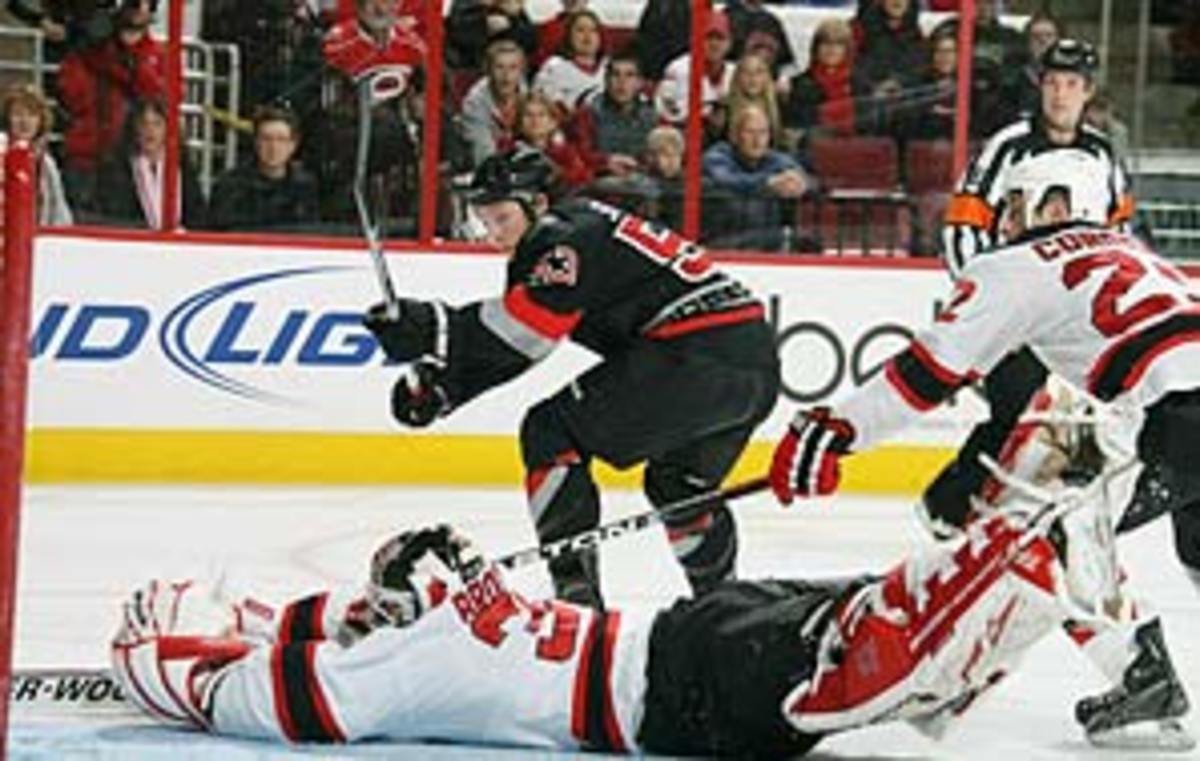Martin Brodeur could learn from Dwayne Roloson
The trade of Dwayne Roloson from the New York Islanders to the Tampa Bay Lightning made me think of Martin Brodeur in New Jersey. While the Devils continue to struggle in a manner not seen since Brodeur took over their goaltending way back in 1992, Roloson received a reprieve with his move to Tampa. At the age of 41, Roloson has something right now that Brodeur, 38, doesn't for the first time in his illustrious career: Hope.
Now, don't get me wrong. This isn't a pity piece. The Devils still pay Brodeur handsomely to tend goal for them, win or lose. And Roloson didn't change his feisty approach while playing for the Islanders despite his 6-13-1 record compared to his astounding 23-18-7 mark of a year ago. Brodeur is simply enduring a stretch like never before. He is 5-18-1 with a goals-against average of 3.15 and a save percentage of .882. Compare that to his being the winningest netminder ever, with marks of 2.23 and .913, and the alarm is obvious, especially since Brodeur is mired in a 1-8 stretch since returning from an elbow injury.
I've had people ask me, "How much does Brodeur have left?" That question amazes me, given Brodeur's numbers last season when he played 77 games and won 45, with a goals-against of 2.24 and a save percentage of .916. Those marks are in line with his Hall-of-Fame career. They didn't foretell his precipitous drop-off. And not many people in the hockey world predicted the Devils would struggle to this degree. We took for granted that they'd find a way to be a competitive top-five team in the Eastern Conference with Brodeur at the center of their success. Instead, we find him facing questions for the first time about whether he has enough left to see the Devils through this dark period.
To me, that is more the question. Yes, Brodeur is coming off a second injury in three seasons, having missed half of the 2008-09 campaign with a torn bicep. For the first time, though, he is faced with overcoming the mental challenge of getting up for games where winning is a tough prospect and his giving up goals at a previously unthought-of rate is more likely. The nightly battle between the ears is different when you're backstopping a successful team compared to the situation Brodeur is going through now with his Devils in their current state.
I'm not saying one is easier than the other. They're just different. You still have to stop the puck, but when a team struggles to score goals like the Devils are, the pressure to be perfect intensifies. Great saves that used to define 3-2 wins are no longer termed "timely" when you lose 4-1. What were, as recently as a season ago, lauded acrobatics now look desperate, as rebounds lead to easy goals instead of defensive clears. Suddenly, crease survival is more of a concern, rather than what it was all about for Brodeur and the Devils for so long: winning. It's a dynamic that Brodeur is enduring for the first time and it is mental, not physical.
Now, the physical and technical parts of the game do play a part in my mind. If the situation around you has changed, considering some adjustments might have merit. Brodeur has always eschewed the default butterfly style, and adhered to the stand-up first, hybrid form of stopping pucks. It made sense for many seasons due to his active puck-handling and the disciplined defensive play around him. But playing the percentages makes more sense now that offenses have evolved and the Devils' blueline is far from what it once was.
The most obvious combination of this premise has to do with long-side rebounds, where players now shoot low, long side while looking to generate a rebound for a teammate who drives the wide or "dot" rather than middle lane. With Brodeur's upright challenge style, he is more susceptible to those second bids than most because his next move is usually a reach or a dive, instead of a push that most goalies today employ.
Historically, If Brodeur had any vulnerability, it was on wrap-around attempts and plays in general that originated from behind the net. Today, with most goalies playing down even when challenging at the top of the crease, offenses have adjusted by adding steep angle plays off the goal line, to catch goaltenders prone before they can push and square up their shoulders. Again, those bids become problematic for Brodeur's one-on-one challenge approach that often leaves him reaching and diving. He is at the point where he has to adjust -- retool his golf swing, if you will. His veteran partner, Johan Hedberg, did it two years ago and had a career season during the last campaign.
Roloson really committed to altering his style during a season in the AHL in 2000-01. It propelled him to a decade of ascent, whether he was playing for playoff-bound teams in Minnesota and Edmonton, or giving his all for a perpetually rebuilding Islanders organization. Now, because of that foresight and fortitude, he has opportunities that Brodeur probably won't have this season -- playing to win more than just surviving as the sole focus on a nightly basis and hoping for more beyond the regular season.






